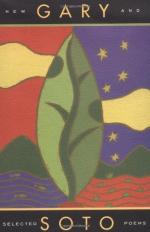|
This section contains 794 words (approx. 3 pages at 300 words per page) |

|
[The essay from which this excerpt is taken was read, in a slightly different version, at the Louisiana Conference on Hispanic Languages and Literatures in Baton Rouge in February 1982.]
One of the principal characteristics of Soto's poetry is the apocalyptic vision it reflects of the universe. Recurring images of loss, disintegration, decadence, demolition, solitude, terror and death create a desolate landscape in which the voice of the narrator is that of a passive, impotent observer, helplessly caught up in the inexorable destruction of human ties. Within this seemingly hopeless, profoundly grey world of Soto's poems, however, occasional affirmative images introduce muted, contrapuntal notes of something akin to hope.
In his first collection, The Elements of San Joaquín, for example, the presence of dust, both from the fields and from the mortal remains of the men who work them, and the action of the wind that sweeps everything...
|
This section contains 794 words (approx. 3 pages at 300 words per page) |

|


